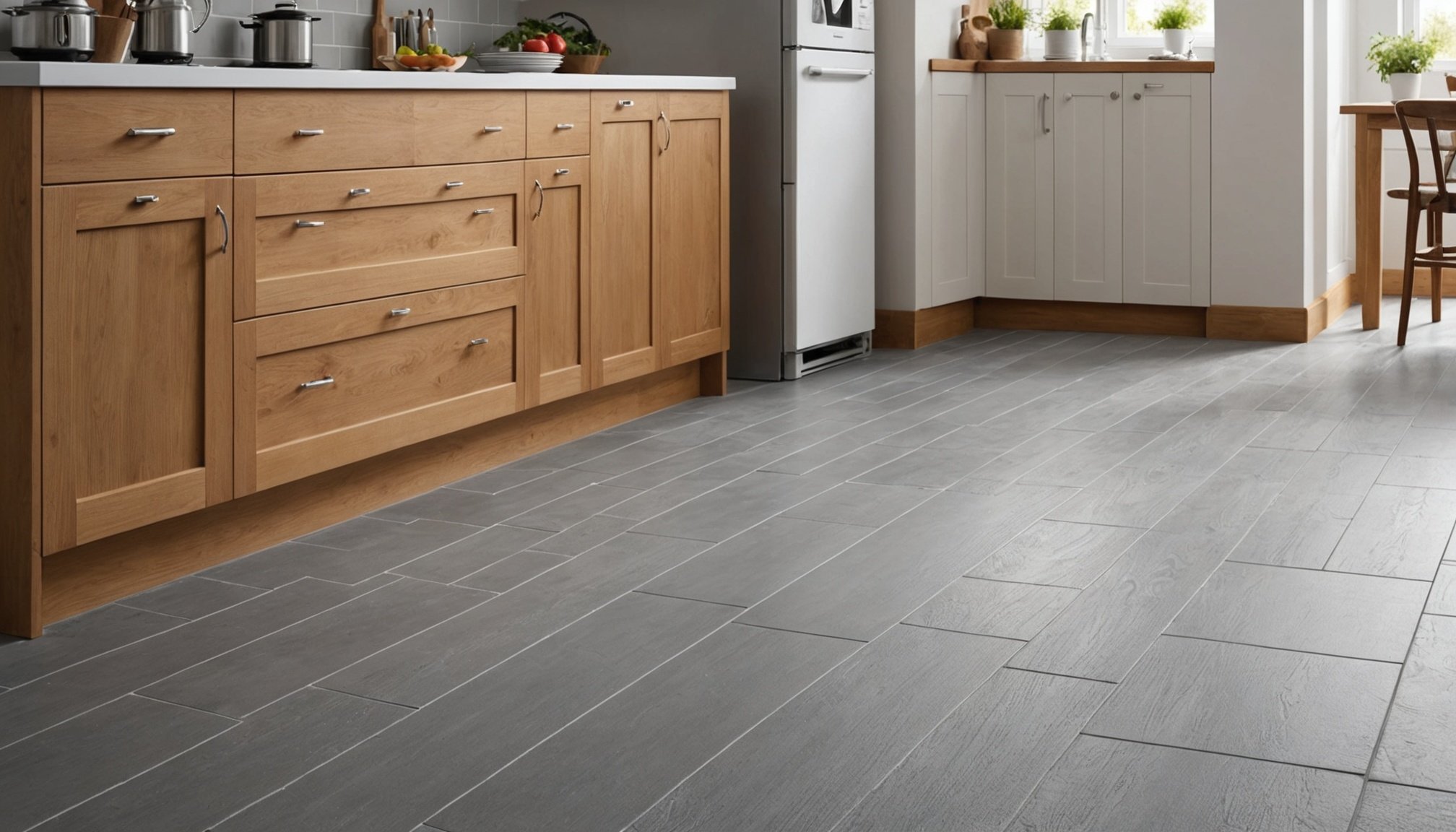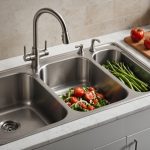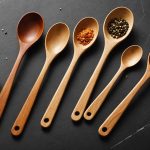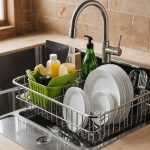Kitchens are often the heart of our homes, but cold floors can dampen both comfort and culinary creativity. Selecting the right thermal insulation materials is essential, especially in the UK's colder climates. This guide not only highlights various insulation options but also focuses on their effectiveness, sustainability, and cost-efficiency. Whether renovating or building new, understanding these materials can transform your kitchen into a warm and inviting space, while enhancing energy efficiency and reducing heating costs. Discover how to make informed decisions that meet your needs.
Overview of Thermal Insulation for Kitchen Floors
Thermal insulation plays a crucial role, especially in colder climates, ensuring your kitchen remains a comfortable and energy-efficient space. By insulating your kitchen floors, you can significantly reduce heat loss, leading to lower energy bills and a more sustainable household.
Have you seen this : Transform your home cooking: discover the advantages of a kitchen garden window for culinary inspiration
Importance in Colder Climates
In regions with harsh winters, thermal insulation becomes indispensable. It minimizes the cold seeping through the floors, maintaining a cozy environment. Proper insulation can prevent the discomfort of cold feet, enhancing the overall living experience.
Benefits of Insulating Kitchen Floors
Insulating your kitchen floors offers several advantages. It helps maintain a consistent indoor temperature, reduces noise, and can even increase the property value. Moreover, energy efficiency is improved, as less heating is required to maintain warmth.
Also read : Finding the Perfect Spot: Tips for Placing a Wine Cooler in Your Cozy Kitchen
Overview of Insulation Materials
A variety of insulation materials are available, each with unique properties. Common options include:
- Fiberglass: Affordable and easy to install.
- Foam Boards: Excellent for moisture resistance.
- Mineral Wool: Provides soundproofing in addition to thermal insulation.
Selecting the right material depends on your specific needs and budget. By understanding the options, you can make informed decisions to enhance your home’s comfort and efficiency.
Top Thermal Insulation Materials
Choosing the right thermal insulation materials is essential for effective kitchen insulation. Each material offers unique benefits and challenges.
Expanded Polystyrene (EPS)
Expanded Polystyrene is a popular choice due to its energy efficiency and cost-effectiveness. EPS provides excellent thermal insulation, making it ideal for kitchen floors. Its lightweight nature simplifies installation, although proper sealing is crucial to prevent moisture ingress.
Characteristics and Benefits:
- Lightweight and easy to handle
- Cost-effective with high thermal resistance
- Suitable for various applications
Installation Considerations:
- Ensure proper sealing to prevent moisture damage
- Consider additional vapor barriers in damp environments
Extruded Polystyrene (XPS)
Extruded Polystyrene stands out for its performance in damp environments. Compared to EPS, XPS offers enhanced moisture resistance and durability, making it a reliable option for kitchen insulation.
Features and Advantages:
- Superior moisture resistance
- High compressive strength
- Long-lasting durability
Comparison with EPS:
- XPS is denser and more durable
- Slightly higher cost but offers better moisture protection
By understanding these kitchen insulation options, homeowners can make informed decisions that enhance comfort and efficiency. Selecting the right material is crucial for achieving optimal energy savings and maintaining a cozy kitchen environment.
Natural Insulation Options
Exploring sustainable insulation with natural materials for a greener home.
Sheep’s Wool
Sheep’s wool is a remarkable sustainable insulation option due to its excellent thermal performance and breathability. This natural material regulates humidity, creating a comfortable indoor environment. Moreover, sheep’s wool is biodegradable and recyclable, making it an environmentally friendly choice for those seeking sustainable insulation solutions.
Environmental Benefits:
- Naturally renewable resource
- Reduces carbon footprint
- Enhances indoor air quality
When installing sheep’s wool, ensure it is properly treated to resist pests and mold. Its natural resilience and elasticity make it easy to fit into irregular spaces, providing effective sustainable insulation.
Cork
Cork offers unique properties, such as sound insulation and thermal efficiency. Harvested from the bark of cork oak trees, it is a truly sustainable insulation material that does not harm the tree. Cork's cellular structure traps air, providing excellent thermal insulation.
Benefits of Cork:
- Lightweight and compressible
- Fire-resistant and hypoallergenic
- Harvested sustainably
Cork's sustainable insulation capabilities make it an ideal choice for eco-conscious homeowners. It also offers aesthetic appeal, adding a natural touch to your kitchen floors. Proper installation involves ensuring it is laid smoothly and securely to maximize its insulating properties.
Installation Tips for Kitchen Floor Insulation
Ensuring a successful insulation installation for a more efficient kitchen.
Preparing the Space for Insulation Installation
Proper preparation is key to a successful insulation installation. Begin by clearing the kitchen area of any furniture and debris. Ensure the floor is clean and dry before starting. This step prevents moisture-related issues and ensures the insulation adheres effectively.
Common Mistakes to Avoid
Avoiding common pitfalls can save time and resources. One frequent error is neglecting to measure the space accurately, leading to material wastage. Ensure you have the right tools and materials before commencing the insulation installation. Another mistake is failing to seal gaps, which can compromise thermal efficiency.
When to Hire a Professional vs. DIY
Deciding between a DIY approach and hiring a professional depends on your skill level and the complexity of the task. For straightforward insulation installations, DIY can be cost-effective. However, complex projects, especially those involving electrical components, might require professional expertise.
Considerations for Professional Help:
- Complex layouts or large areas
- Limited DIY experience
- Need for specialized tools
By understanding these aspects, you can make informed decisions regarding your kitchen floor insulation installation, ensuring a comfortable and energy-efficient home.
Cost Comparisons of Insulation Materials
Exploring the financial aspects of kitchen floor insulation for informed decision-making.
Average Costs of Different Insulation Types
When considering insulation costs, understanding the range of options is crucial. For example, fiberglass insulation is typically affordable, with prices in the UK ranging from £3 to £5 per square meter. Foam boards, known for their moisture resistance, can cost between £10 and £15 per square meter. More premium options like mineral wool might range from £8 to £12 per square meter.
Long-term Savings on Energy Bills
Investing in quality insulation can lead to substantial long-term savings. Properly insulated kitchen floors can reduce heat loss, potentially lowering energy bills by up to 15%. This makes the initial insulation costs a worthwhile investment, as the savings accumulate over time, enhancing your household budget.
Cost-Benefit Analysis of Various Materials
To make an informed choice, consider a cost-benefit analysis:
- Fiberglass: Low initial cost, moderate energy savings.
- Foam Boards: Higher initial cost, excellent moisture resistance, and energy savings.
- Mineral Wool: Moderate cost, superior soundproofing and thermal efficiency.
By evaluating these factors, you can align your budget considerations with your insulation needs, ensuring both financial and thermal efficiency.
Performance in UK Weather Conditions
Understanding material suitability for the UK's unique climate.
Insulation Performance in Cold and Damp Conditions
In the UK climate, characterized by cold and damp conditions, selecting the right insulation materials is crucial. Fiberglass and mineral wool provide effective thermal resistance but may struggle with moisture unless properly sealed. Foam boards, particularly extruded polystyrene (XPS), excel due to their inherent moisture resistance.
Importance of Moisture Resistance
Moisture resistance is vital in the UK climate, where dampness can compromise insulation effectiveness. Materials like XPS and cork are recommended for their ability to withstand moisture, ensuring long-term performance. This resistance not only preserves thermal efficiency but also prevents mold and structural damage.
Regional Considerations in Material Selection
Choosing insulation for the UK climate requires understanding regional weather patterns. In areas prone to high humidity, prioritize moisture-resistant materials. Coastal regions, for instance, benefit from XPS due to its superior weather resistance.
Material Suitability for UK Conditions:
- Fiberglass: Cost-effective, requires sealing
- Mineral Wool: Good thermal and soundproofing, needs moisture barrier
- XPS: High moisture resistance, ideal for damp areas
By considering these factors, homeowners can select insulation that withstands the UK climate, ensuring energy efficiency and comfort.
Expert Opinions on Thermal Insulation
Insights from professionals to guide your kitchen insulation choices.
Interviews with Insulation Specialists
Industry standards emphasize the importance of selecting the right thermal insulation for your kitchen. According to Dr. Emily Carter, a leading insulation engineer, "Choosing materials that align with your kitchen's specific needs and climate conditions is crucial." Experts suggest that for kitchens with high humidity, extruded polystyrene (XPS) is highly recommended due to its superior moisture resistance.
Recommendations for Specific Materials Based on Kitchen Type
Professionals recommend expanded polystyrene (EPS) for kitchens where cost-effectiveness is a priority. Its lightweight nature and ease of installation make it a preferred choice for many homeowners. Conversely, for open-plan kitchens, mineral wool is advised for its excellent soundproofing and thermal properties. Below is a concise table summarizing these recommendations:
| Kitchen Type | Recommended Material | Key Benefit |
|---|---|---|
| High Humidity | XPS | Moisture Resistance |
| Cost-Conscious | EPS | Affordability |
| Open-Plan | Mineral Wool | Soundproofing |
Trends in Insulation Technology and Materials
Emerging trends in insulation technology focus on sustainability and efficiency. The use of natural materials like sheep’s wool and cork is increasing, driven by environmental concerns. Specialists highlight that innovations in insulation materials are continually improving energy efficiency, making it easier for homeowners to maintain comfortable indoor climates.
User Reviews and Case Studies
Insights into real-world applications and experiences with insulation materials.
Summary of User Experiences
Customer feedback highlights the effectiveness of various insulation materials in real-world applications. Many homeowners report that mineral wool significantly enhances soundproofing, creating a peaceful kitchen environment. Foam boards receive praise for their moisture resistance, particularly in damp climates. However, some users note challenges with installation, emphasizing the importance of professional guidance.
Case Studies of Successful Projects
Real-world applications demonstrate the insulation effectiveness of different materials. In one case study, a London-based homeowner utilized extruded polystyrene (XPS) for kitchen floor insulation, resulting in a 20% reduction in energy bills. Another project in Manchester showcased the benefits of sheep’s wool, where the natural material improved indoor air quality and thermal comfort.
Analysis of Common Challenges
Homeowners frequently encounter challenges with kitchen insulation, such as improper material selection and inadequate sealing. Addressing these issues can enhance insulation effectiveness. To mitigate such challenges, consider the following:
- Evaluate climate conditions before choosing materials
- Consult professionals for complex installations
- Seal gaps thoroughly to maximize thermal efficiency
By understanding these insights, homeowners can navigate the complexities of kitchen insulation, ensuring optimal performance and customer satisfaction.
Maintenance and Longevity of Insulation Materials
Ensuring your kitchen floor insulation remains effective and long-lasting.
Maintaining Insulation Effectiveness
Regular insulation maintenance is crucial for preserving its efficiency. Inspect your kitchen floor insulation periodically for any signs of wear. Look for moisture accumulation or physical damage, as these can significantly reduce performance. Addressing issues promptly can prevent further deterioration and maintain optimal thermal resistance.
Signs of Wear and Replacement Indicators
Recognizing when to replace insulation is essential for maintaining its effectiveness. Common signs of wear include sagging, dampness, and increased energy bills. If you notice these symptoms, it may be time to consider new insulation. Regular checks can help identify these issues early, extending your insulation's lifespan.
Tips for Prolonging Insulation Life
To extend the lifespan of your kitchen floor insulation, follow these upkeep tips:
- Keep the area dry to prevent moisture damage.
- Seal any gaps or cracks to maintain thermal efficiency.
- Avoid placing heavy objects that could compress the insulation.
By incorporating these practices, you can ensure your insulation remains effective and durable, optimizing your kitchen's energy efficiency. Regular maintenance not only prolongs the material's lifespan but also enhances its overall performance.
Future Trends in Thermal Insulation
Exploring the next generation of insulation solutions.
Emerging Technologies in Insulation Materials
The future of thermal insulation is poised for transformation with innovative insulation technologies. Researchers are developing future materials that incorporate advanced aerogels and nanotechnology, offering superior thermal performance. These materials are expected to revolutionize kitchen floor insulation, providing enhanced efficiency and durability.
Focus on Sustainability and Eco-Friendly Options
As environmental concerns grow, the focus is shifting towards sustainability in insulation. Emerging eco-friendly options include bio-based foams and recycled materials. These future materials not only reduce carbon footprints but also promote healthier indoor environments. The trend towards innovative insulation is driven by the need for sustainable living solutions.
Benefits of Sustainable Insulation:
- Reduces energy consumption
- Minimizes environmental impact
- Enhances indoor air quality
Predictions for the Future of Kitchen Floor Insulation in the UK
In the UK, kitchen floor insulation is expected to evolve with innovative insulation solutions. Predictions indicate a rise in demand for sustainable and future materials that cater to the unique climate conditions. As technology advances, homeowners will benefit from more efficient and eco-friendly options, ensuring comfort and energy savings.











